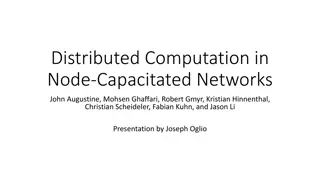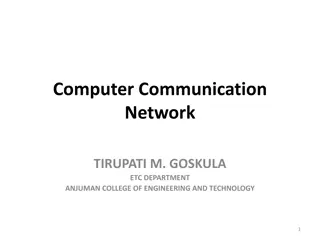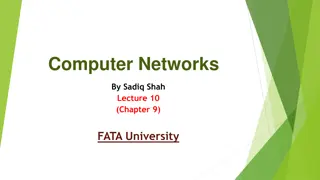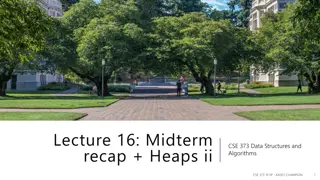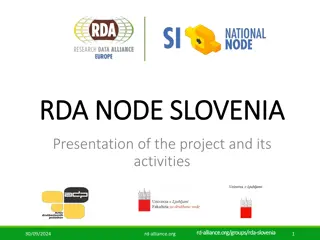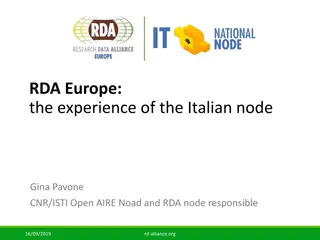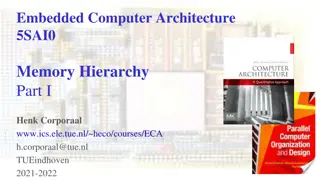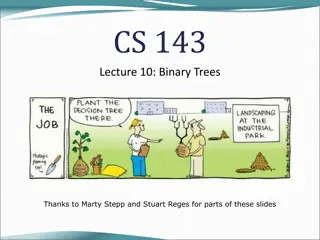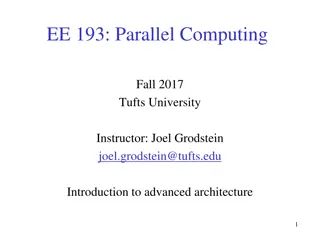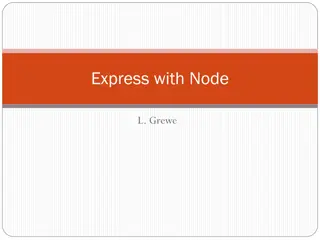Single Node Architecture in Advanced Computer Networks
In this content, Mahdi Sadeghizadeh discusses the intricacies of single node architecture in advanced computer networks. The topics covered include sensor node architecture, energy consumption, runtime environments, main components of a WSN node, controller options, communication subsystems, and transceiver characteristics. These detailed insights shed light on crucial aspects of designing and optimizing network systems.
Download Presentation

Please find below an Image/Link to download the presentation.
The content on the website is provided AS IS for your information and personal use only. It may not be sold, licensed, or shared on other websites without obtaining consent from the author.If you encounter any issues during the download, it is possible that the publisher has removed the file from their server.
You are allowed to download the files provided on this website for personal or commercial use, subject to the condition that they are used lawfully. All files are the property of their respective owners.
The content on the website is provided AS IS for your information and personal use only. It may not be sold, licensed, or shared on other websites without obtaining consent from the author.
E N D
Presentation Transcript
6.3 Single Node Architecture Advanced Computer Networks By: Mahdi Sadeghizadeh Website: Sadeghizadeh.ir 1
Single Node Architecture Sensor node architecture Energy supply and consumption Runtime environments for sensor nodes Case study: TinyOS Mahdi Sadeghizadeh Website: Sadeghizadeh.ir Advanced Networks 2
Sensor node architecture Main components of a WSN node Controller Communication device(s) Sensors/actuators Memory Power supply Memory Communication device Sensor(s)/ actuator(s) Controller Power supply Mahdi Sadeghizadeh Website: Sadeghizadeh.ir Advanced Networks 3
Controller (Processing Subsystem) Main options: Microcontroller general purpose processor, optimized for embedded applications, low power consumption, sleep state DSPs optimized for signal processing tasks, not suitable here FPGAs may be good for testing ASICs only when peak performance is needed, no flexibility purpose general purpose Single Example microcontrollers Texas Instruments MSP430 16-bit RISC core, up to 4 MHz, versions with 2-10 kbytes RAM, several DACs, RT clock, prices start at 0.49 US$ Atmel ATMega 8-bit controller, larger memory than MSP430, slower Mahdi Sadeghizadeh Website: Sadeghizadeh.ir Advanced Networks 4
Communication device (Communication Subsystem) Which transmission medium? Electromagnetic at radio frequencies? Electromagnetic, light? Ultrasound? Radio transceivers transmit a bit- or byte stream as radio wave Receive it, convert it back into bit-/byte stream Mahdi Sadeghizadeh Website: Sadeghizadeh.ir Advanced Networks
Transceiver characteristics Radio performance Modulation? (ASK, FSK, ?) Noise figure? NF = SNRI/SNRO Gain? (signal amplification) Receiver sensitivity? (minimum S to achieve a given Eb/N0) Blocking performance (achieved BER in presence of frequency- offset interferer) Out of band emissions Carrier sensing & RSSI characteristics Frequency stability (e.g., towards temperature changes) Voltage range Capabilities Interface: bit, byte, packet level? Supported frequency range? Typically, somewhere in 433 MHz 2.4 GHz, ISM band Multiple channels? Data rates? Range? Energy characteristics Power consumption to send/receive data? Time and energy consumption to change between different states? Transmission power control? Power efficiency (which percentage of consumed power is radiated?) 6 Mahdi Sadeghizadeh Website: Sadeghizadeh.ir Advanced Networks
Transceiver states Transceivers can be put into different operational states, typically: Transmit Receive Idle ready to receive, but not doing so Some functions in hardware can be switched off, reducing energy consumption a little Sleep significant parts of the transceiver are switched off Not able to immediately receive something Recovery time and startup energy to leave sleep state can be significant Research issue: Wakeup receivers can be woken via radio when in sleep state (seeming contradiction!) Mahdi Sadeghizadeh Website: Sadeghizadeh.ir Advanced Networks 7
Wakeup receivers Major energy problem: RECEIVING Idling and being ready to receive consumes considerable amounts of power When to switch on a receiver is not clear Contention-based MAC protocols: Receiver is always on TDMA-based MAC protocols: Synchronization overhead, inflexible Desirable: Receiver that can (only) check for incoming messages When signal detected, wake up main receiver for actual reception Ideally: Wakeup receiver can already process simple addresses Not clear whether they can be actually built, however Mahdi Sadeghizadeh Website: Sadeghizadeh.ir Advanced Networks 8
Sensors (Sensor Subsystem) Main categories Any energy radiated? Passive vs. active sensors Sense of direction? Omidirectional? Passive, omnidirectional Examples: light, thermometer, microphones, hygrometer, Passive, narrow-beam Example: Camera Active sensors Example: Radar Important parameter: Area of coverage Which region is adequately covered by a given sensor? Mahdi Sadeghizadeh Website: Sadeghizadeh.ir Advanced Networks 9
Energy supply of mobile/sensor nodes Goal: provide as much energy as possible at smallest cost/volume/weight/recharge time/longevity In WSN, recharging may or may not be an option Options Primary batteries not rechargeable Secondary batteries rechargeable, only makes sense in combination with some form of energy harvesting Requirements include Low self-discharge Long shelf live Capacity under load Efficient recharging at low current Good relaxation properties (seeming self-recharging) Voltage stability (to avoid DC-DC conversion) Mahdi Sadeghizadeh Website: Sadeghizadeh.ir Advanced Networks 10
Battery examples Energy per volume (Joule per cubic centimeter): Primary batteries Chemistry Zinc-air Lithium Alkaline Energy (J/cm3) 3780 2880 1200 Secondary batteries Chemistry Lithium NiMHd NiCd Energy (J/cm3) 1080 860 650 Mahdi Sadeghizadeh Website: Sadeghizadeh.ir Advanced Networks 11
Energy scavenging How to recharge a battery? A laptop: easy, plug into wall socket in the evening A sensor node? Try to scavenge energy from environment Ambient energy sources Light ! solar cells between 10 W/cm2 and 15 mW/cm2 Temperature gradients 80 W/cm2 @ 1 V from 5K difference Vibrations between 0.1 and 10000 W/cm3 Pressure variation (piezo-electric) 330 W/cm2 from the heel of a shoe Air/liquid flow (MEMS gas turbines) Mahdi Sadeghizadeh Website: Sadeghizadeh.ir Advanced Networks 12
Energy scavenging overview Mahdi Sadeghizadeh Website: Sadeghizadeh.ir Advanced Networks 13
Energy consumption A back of the envelope estimation Number of instructions Energy per instruction: 1 nJ Small battery ( smart dust ): 1 J = 1 Ws Corresponds: 109 instructions! Lifetime Or: Require a single day operational lifetime = 24 60 60 =86400 s 1 Ws / 86400s 11.5 W as max. sustained power consumption! Not feasible! Mahdi Sadeghizadeh Website: Sadeghizadeh.ir Advanced Networks 14
Multiple power consumption modes Way out: Do not run sensor node at full operation all the time If nothing to do, switch to power safe mode Question: When to throttle down? How to wake up again? Typical modes Controller: Active, idle, sleep Radio mode: Turn on/off transmitter/receiver, both Multiple modes possible, deeper sleep modes Strongly depends on hardware TI MSP 430, e.g.: four different sleep modes Atmel ATMega: six different modes Mahdi Sadeghizadeh Website: Sadeghizadeh.ir Advanced Networks 15
Some energy consumption figures Microcontroller TI MSP 430 (@ 1 MHz, 3V): Fully operation 1.2 mW Deepest sleep mode 0.3 W only woken up by external interrupts (not even timer is running any more) Atmel ATMega Operational mode: 15 mW active, 6 mW idle Sleep mode: 75 W Mahdi Sadeghizadeh Website: Sadeghizadeh.ir Advanced Networks 16
Switching between modes Simplest idea: Greedily switch to lower mode whenever possible Problem: Time and power consumption required to reach higher modes not negligible Introduces overhead Switching only pays off if Esaved > Eoverhead Esaved Example: Event-triggered wake up from sleep mode Eoverhead Pactive Psleep Scheduling problem with uncertainty (exercise) t1 tevent time down up Mahdi Sadeghizadeh Website: Sadeghizadeh.ir Advanced Networks 17
Alternative: Dynamic voltage scaling Switching modes complicated by uncertainty how long a sleep time is available Alternative: Low supply voltage & clock Dynamic voltage scaling (DVS) Rationale: Power consumption P depends on Clock frequency Square of supply voltage P / f V2 Lower clock allows lower supply voltage Easy to switch to higher clock But: execution takes longer Mahdi Sadeghizadeh Website: Sadeghizadeh.ir Advanced Networks 18
Memory power consumption Crucial part: FLASH memory Power for RAM almost negligible FLASH writing/erasing is expensive Example: FLASH on Mica motes Reading: 1.1 nAh per byte Writing: 83.3 nAh per byte Mahdi Sadeghizadeh Website: Sadeghizadeh.ir Advanced Networks 19
Transmitter power/energy consumption for n bits Amplifier power: Ptx radiated power amp, amp constants depending on model Highest efficiency ( = Ptx / Pamp ) at maximum output power In addition: transmitter electronics needs power PtxElec Time to transmit n bits: n / (R Rcode) R nomial data rate, Rcode coding rate To leave sleep mode Time Tstart, average power Pstart Simplification: Modulation not considered Mahdi Sadeghizadeh Website: Sadeghizadeh.ir Advanced Networks 20
Receiver power/energy consumption for n bits Receiver also has startup costs Time Tstart, average power Pstart Time for n bits is the same n / (R Rcode) Receiver electronics needs PrxElec Plus: energy to decode every bit EdecBits Mahdi Sadeghizadeh Website: Sadeghizadeh.ir Advanced Networks 21
Some transceiver numbers Mahdi Sadeghizadeh Website: Sadeghizadeh.ir Advanced Networks 22
Controlling transceivers Similar to controller, low duty cycle is necessary Easy to do for transmitter similar problem to controller: when is it worthwhile to switch off Difficult for receiver: Not only time when to wake up not known, it also depends on remote partners ! Dependence between MAC protocols and power consumption is strong! Only limited applicability of techniques analogue to DVS Dynamic Modulation Scaling (DSM): Switch to modulation best suited to communication depends on channel gain Dynamic Coding Scaling vary coding rate according to channel gain Combinations Mahdi Sadeghizadeh Website: Sadeghizadeh.ir Advanced Networks 23
Computation vs. communication energy cost Tradeoff? Directly comparing computation/communication energy cost not possible But: put them into perspective! Energy ratio of sending one bit vs. computing one instruction : Anything between 220 and 2900 in the literature To communicate (send & receive) one kilobyte over 100 m = computing three million instructions! Hence: try to compute instead of communicate whenever possible Key technique in WSN in-network processing! Exploit compression schemes, intelligent coding schemes, Mahdi Sadeghizadeh Website: Sadeghizadeh.ir Advanced Networks 24
Operating system challenges in WSN Usual operating system goals Make access to device resources abstract (virtualization) Protect resources from concurrent access Usual means Protected operation modes of the CPU hardware access only in these modes Process with separate address spaces Support by a memory management unit Problem: These are not available in microcontrollers No separate protection modes, no memory management unit Would make devices more expensive, more power-hungry Mahdi Sadeghizadeh Website: Sadeghizadeh.ir Advanced Networks 25
WSN: Open Source Tools Programming Languages Simulators NS-2 TOSSIM Avrora NCTUns OMNET++ J-Sim Ptolemy Assembly C Giotto Esterel Lustre Signal E-FRP nesC Operating Systems Application Tools TinyOS YATOS Contiki MANTIS SOS Localization Tools TinyDB Surge TOSBase Mahdi Sadeghizadeh Website: Sadeghizadeh.ir Advanced Networks
Operating system challenges in WSN Possible options Try to implement as close to an operating system on WSN nodes In particular, try to provide a known programming interface Namely: support for processes! Sacrifice protection of different processes from each other ! Possible, but relatively high overhead Do (more or less) away with operating system After all, there is only a single application running on a WSN node No need to protect malicious software parts from each other Direct hardware control by application might improve efficiency Currently popular verdict: no OS, just a simple run-time environment Enough to abstract away hardware access details Biggest impact: Unusual programming model Mahdi Sadeghizadeh Website: Sadeghizadeh.ir Advanced Networks 27
Main issue: How to support concurrency Simplest option: No concurrency, sequential processing of tasks Not satisfactory: Risk of missing data (e.g., from transceiver) when processing data, etc. ! Interrupts/asynchronous operation has to be supported Poll sensor Process sensor data Poll transceiver Why concurrency is needed Sensor node s CPU has to service the radio modem, the actual sensors, perform computation for application, execute communication protocol software, etc. Process received packet Mahdi Sadeghizadeh Website: Sadeghizadeh.ir Advanced Networks 28
Traditional concurrency: Processes Handle sensor process Handle packet process Traditional OS: processes/threads Based on interrupts, context switching But: not available memory overhead, execution overhead But: concurrency mismatch One process per protocol entails too many context switches Many tasks in WSN small with respect to context switching overhead And: protection between processes not needed in WSN Only one application anyway OS-mediated process switching Mahdi Sadeghizadeh Website: Sadeghizadeh.ir Advanced Networks 29
Event-based concurrency Alternative: Switch to event-based programming model Perform regular processing or be idle React to events when they happen immediately Basically: interrupt handler Problem: must not remain in interrupt handler too long Danger of loosing events Only save data, post information that event has happened, then return ! Run-to-completion principle Two contexts: one for handlers, one for regular execution Radio event Sensor event Idle/Regular processing Radio eventhandler Sensor event handler Mahdi Sadeghizadeh Website: Sadeghizadeh.ir Advanced Networks 30
Components instead of processes Need an abstraction to group functionality Replacing processes for this purpose E.g.: individual functions of a networking protocol One option: Components Here: In the sense of TinyOS Typically fulfill only a single, well-defined function Main difference to processes: Component does not have an execution Components access same address space, no protection against each other NOT to be confused with component-based programming! API to an event-based protocol stack Mahdi Sadeghizadeh Website: Sadeghizadeh.ir Advanced Networks 31
Case study embedded OS: TinyOS & nesC TinyOS developed by UC Berkely as runtime environment for their motes nesC as adjunct programming language Goal: Small memory footprint Sacrifices made e.g. in ease of use, portability Portability somewhat improved in newer version Most important design aspects Component-based system Components interact by exchanging asynchronous events Components form a program by wiring them together (akin to VHDL hardware description language) Mahdi Sadeghizadeh Website: Sadeghizadeh.ir Advanced Networks 32
TinyOS components Components Frame state information Tasks normal execution program Command handlers Event handlers Handlers Must run to completion Form a component s interface Understand and emits commands & events Hierarchically arranged Events pass upward from hardware to higher-level components Commands are passed downward stop fired init start Command handlers Frame TimerComponent Event handlers Tasks fire setRate Mahdi Sadeghizadeh Website: Sadeghizadeh.ir Advanced Networks 33
Handlers versus tasks Command handlers and events must run to completion Must not wait an indeterminate amount of time Only a request to perform some action Tasks, on the other hand, can perform arbitrary, long computation Also have to be run to completion since no non-cooperative multi-tasking is implemented But can be interrupted by handlers ! No need for stack management, tasks are atomic with respect to each other Mahdi Sadeghizadeh Website: Sadeghizadeh.ir Advanced Networks 34
Structuring commands/events into interfaces Many commands/events can add up nesC solution: Structure corresponding commands/events into interface types Example: Structure timer into three interfaces StdCtrl Timer Clock stop fired start init StdCtrl Timer Build configurations by wiring together corresponding interfaces TimerComponent Clock setRate fire Mahdi Sadeghizadeh Website: Sadeghizadeh.ir Advanced Networks 35
Building components out of simpler ones Wire together components to form more complex components out of simpler ones New interfaces for the complex component StdCtrl Timer StdCtrl Timer TimerComponent Clock Clock HWClock CompleteTimer Mahdi Sadeghizadeh Website: Sadeghizadeh.ir Advanced Networks 36
Defining modules and components in nesC Mahdi Sadeghizadeh Website: Sadeghizadeh.ir Advanced Networks 37
Wiring components to form a configuration Mahdi Sadeghizadeh Website: Sadeghizadeh.ir Advanced Networks 38
Thank You 39











